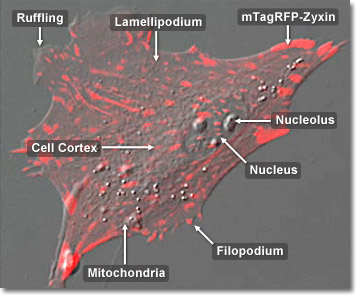Focal adhesions, often referred to as cell-matrix adhesions, are complex structures composed of many protein components that serve as a mechanical anchor for the cell to a substrate. These assemblies also serve as a "molecular" bridge between the cytoskeletal network and the extracellular matrix. A typical focal adhesion usually contains up to a hundred or more different proteins, an indicator of the high level of structural and functional diversity that is slowly being uncovered in advanced optical microscopy investigations. The confocal digital video presented above captures several Gray fox lung fibroblast cells (FoLu line) as they progress across the glass coverslip, extruding and contracting the leading edges of their lamellipodia as well as building and disassembling focal adhesions. Zyxin, a component in focal adhesions, is labeled as a fusion partner with mKusabira Orange fluorescent protein.
Video 1 - Run Time: 69 Seconds
Video 2 - Run Time: 53 Seconds
Video 3 - Run Time: 67 Seconds
Video 4 - Run Time: 50 Seconds
Video 5 - Run Time: 54 Seconds
Anchored to the medium outside the cell, focal adhesions transfer mechanical forces to the cell's interior. Transmitted mechanical forces alert the cell to any changes in surrounding tensions thereby influencing a change in cell behavior as a response. For example, certain mechanical forces stimulate the growth of more focal adhesions by activating particular enzymes, such as laminin and collagen. At an applied pulling force, a focal adhesion will lengthen in response, adding more molecules to its anchoring chain in the direction of the force. Conversely, the adhesion complex will dissociate once the force is no longer present. The confocal digital video presented above captures a Gray fox lung fibroblast cell (FoLu line) as it progresses across the glass coverslip, extruding and contracting the leading edges of the lamellipodia as well as building and disassembling focal adhesions. Zyxin, a component in focal adhesions, is labeled with a fusion of mKusabira Orange fluorescent protein.

Focal adhesions are large assemblies of molecules through which the cell can anchor itself to the extracellular matrix. The cell connects with the surrounding media through the protein integrin, which links to actin filaments, the cytoskeletal components that shape the cell structurally. The connection of focal adhesions to the outside world makes them ideal for transmitting mechanical forces and signals containing information about the surrounding conditions. Inside the cell, focal adhesions connect with actin filaments through a series of protein-protein connections making the entire focal adhesion site a macromolecular complex. The confocal digital video presented above captures a Gray fox lung fibroblast cell (FoLu line) as it progresses across the glass coverslip, extruding and contracting the leading edges of the lamellipodia as well as building and disassembling focal adhesions. Zyxin, a component in focal adhesions, is labeled with a fusion of mKusabira Orange fluorescent protein.